| |
|
|
Thou shalt not lie with mankind, as
with womankind: it is abomination.
|
|
Leviticus 18:22
|
The ancients seem to have accepted homosexuality without too
much concern. Plato recounts a myth that sets both male and
female homosexuality firmly within the realm of normality1.
Zeus himself kept a catamite (young male lover), his cup-bearer
Ganymede. And no one thought less of Alexander the Great because
of his male lover, nor found it odd that one of his best fighting
units was composed exclusively of homosexual couples.
Christianity brought new attitudes, more extreme than those
of its parent religion, Judaism. Homosexual sex was now an outrage.
The Church's view on this matter was founded in the scripture
cited above "Thou shalt not lie with mankind, as with womankind:
it is abomination". This however was not thought to be
a strong enough indictment, so the early Church reconstrued
the story of Sodom and Gomorrah. To the Jews, Sodom had traditionally
been identified with shortcomings such as irreligiousness, pride,
and adultery. It was these wrongdoings that they thought had
incurred the wrath of God. Only later, when they came to be
outraged by liberal Hellenistic and Roman attitudes to sex,
did they start to associate the cities of the plain with misdeeds
such as fornication and homosexuality2.
It was Philo of Alexandria, living in the first century AD,
who seems to have first interpreted the story as one principally
about homosexuality, and this was the version that the Church
Fathers preferred3.
So it is that, to this day, anal intercourse and sometimes other
sexual practices are referred to as sodomy, and practising
male homosexuals as sodomites or sods. (Several
American states still regard sodomy as encompassing any form
of intercourse other than that carried out using the missionary
position).
|
Lot Leaving Sodom, Woodcut, 1493.
Sodom is being destroyed by God. Lot's wife has been turned
into a pillar of salt.
|
|
|
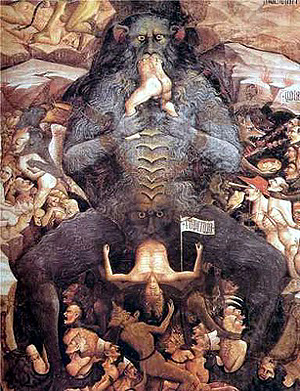  As
the Roman Empire crumbled, the Church succeeded in replacing
traditional sexual liberality. Homosexuals were soon being punished
by forcible castration and public display4. As
the Roman Empire crumbled, the Church succeeded in replacing
traditional sexual liberality. Homosexuals were soon being punished
by forcible castration and public display4.
In 342, the Christian Emperors Constantius II and Constans
declared the death penalty for any man who took on the passive
role of a bride. In 390, the Christian emperors Valentinian
II, Theodosius I and Arcadius denounced males "acting the
part of a woman", and condemned those who were guilty of
such acts to be publicly burned.[y5,
and this was confirmed by the Code of Justinian in the sixth
century. Through Gratian's Decretum the death penalty
was adopted by European nations, for example under Edward I
in England and Louis IX in France. Alfonso X of Castile favoured
castration followed by hanging upside down until dead, but at
the end of the fifteenth century Ferdinand and Isabella changed
this to the more traditional burning.
According to the Golden Legend all sodomites throughout
the whole world had been divinely exterminated in preparation
for Jesus Christ's arrival, but somehow the practice had become
popular again. In Europe, homosexuals were burned to death like
heretics throughout the Middle Ages — the non-clerical
ones at least. The French continued to burn homosexuals as late
as 17256.
  For
centuries heresy and homosexuality went together in the Christian
mind, twin evils both deserving of death. Virtually all non-Christians
were believed to practice homosexuality, and virtually all heretical
groups were accused of it as well, whether or not there was
any evidence. One such heretical group is particularly notable
in this respect, the Bulgarians a group of Gnostic
Dualists related to the Cathars.
They flourished in the eleventh century, and as the name suggests
were based in Bulgaria. In Old French a Bulgarian was a boulgre,
modern French bougre. In English the word adopted another
spelling — bugger. Historically it was applied
to a succession of heretical groups, each of which was accused
of sodomy. So it is that under the headword bugger
the Oxford English Dictionary gives two definitions: the first
obsolete "A heretic ...", the second current, "One
who commits buggery; a sodomite ...". (If the Bulgars really
did practice anal intercourse, it was almost certainly with
their wives and for contraceptive reasons. Anal intercourse
between man and wife was a common form of contraception throughout
Christendom for many centuries7.) For
centuries heresy and homosexuality went together in the Christian
mind, twin evils both deserving of death. Virtually all non-Christians
were believed to practice homosexuality, and virtually all heretical
groups were accused of it as well, whether or not there was
any evidence. One such heretical group is particularly notable
in this respect, the Bulgarians a group of Gnostic
Dualists related to the Cathars.
They flourished in the eleventh century, and as the name suggests
were based in Bulgaria. In Old French a Bulgarian was a boulgre,
modern French bougre. In English the word adopted another
spelling — bugger. Historically it was applied
to a succession of heretical groups, each of which was accused
of sodomy. So it is that under the headword bugger
the Oxford English Dictionary gives two definitions: the first
obsolete "A heretic ...", the second current, "One
who commits buggery; a sodomite ...". (If the Bulgars really
did practice anal intercourse, it was almost certainly with
their wives and for contraceptive reasons. Anal intercourse
between man and wife was a common form of contraception throughout
Christendom for many centuries7.)
|
Detail of Saint Francis of Assisi in
Ecstasy by Caravaggio (c.1595)
While homosexuality was always heavily criticised by Church
leaders, there are many hints, such as monastic rules,
penitentials, and secular jokes that it was always common
within the Church.
Paintings of visions, like the accounts of visionaries,
often have strong sexual overtones,
homoerotic in the case of male ecstatics
|
|
|
A few people executed during the Christian hegemony of Europe
include:
- Giovanni di Giovanni (1350 – 1365), 15 year old Italian
boy, whose prosecution came soon after the outbreak of the
Black Death in Florence. Religious leaders like Bernardino
of Siena blamed sodomites for having brought the wrath of
God down on the heads of the populace. They wanted to purify
the city by means of fire, leading to burnings at the stake
and other punishments such as that suffered by Giovanni DI
Giovanni. His punishment was to be paraded on the back of
an ass, then to be publicly castrated. Finally, he was to
have a red-hot iron inserted into his anus "that part
of the body where he allowed himself to be known in sodomitical
practice"
- Jacopo Bonfadio (c1508 – 1550), Italian humanist and
historian. His humanist views earned him powerful enemies
in Genoa, who accused him of sodomy. For this alleged crime
he was arrested, tried and condemned to death. He was beheaded,
and his body then burnt. The records of his trial have been
"lost".
- Dominique Phinot (c1510 – c1556), French composer of
the Renaissance, According to Cardano he was executed for
"homosexual practices", probably in Lyon in 1556.
Details have been "lost"
- Francesco Calcagno (1528 - 1550) was a young Franciscan
friar executed for blasphemy and sodomy by the Venetian Inquisition.
A twenty-two-year-old Franciscan friar from Brescia, Calcagno
was interrogated in Brescia on 15 July 1550 and executed in
Venice on 23 December 1550, after an investigation by the
Holy Office of the Venetian Inquisition.
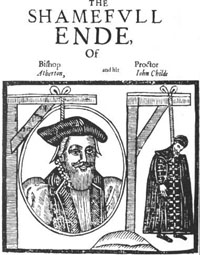 
- John Atherton (1598 – 1640) and John Childe. Atherton
was the Protestant Bishop of Waterford and Lismore in the
Church of Ireland. He and John Childe (his steward and tithe
proctor) were tried for buggery in 1640, and executed on St
Stephen's Green in Dublin.
- Lisbetha Olsdotter (died 1679), Olsdotter was a Swedish
cross-dressing woman. Disguised as a man she became a soldier.
She was judged guilty of the charges under a religious law
of 1655; for having, with full intent, "mutilated her
gender", "mocked God and the Order of God",
and fooled her "fellow Christians" by impersonating
a man. She was sentenced to death by decapitation. The Royal
court confirmed the verdict on 12 November, and ordered the
priests to clarify for her what sin she had committed in the
eyes of the Christian religion.8
She was decapitated on Hötorget in Stockholm in 1679.
In most countries, records have not been kept, or if kept,
have not been systematically studied. One exception where dozens
of cases in Italy the sixteenth century alone, suggest that
thoroughout Europe thousands must have been executed9
.
|
Five Catholic monks were burnt to death
in Ghent for homosexuality on June 28, 1578,
These were 5 of 14 homosexual monks executed by Calvinists
in Ghent around this time
|
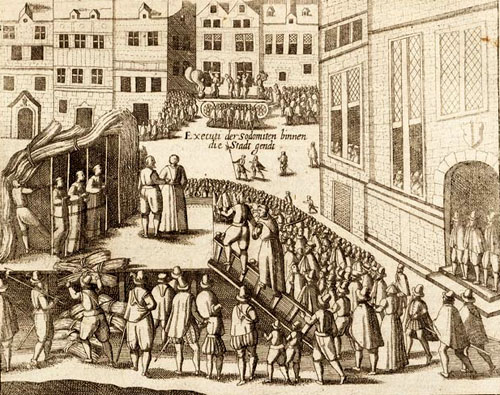 |
Like Catholics, Anglicans, Lutherans and Calvinists all cited
the bible as justification for the capital punishment of homosexuals.
Martin Luther viewed homosexuality as satanic. His views are
recorded in Plass's What Luther Says:
The vice of the Sodomites is an unparalleled enormity. It
departs from the natural passion and desire, planted into
nature by God, according to which the male has a passionate
desire for the female. Sodomy craves what is entirely contrary
to nature. Whence comes this perversion? Without a doubt it
comes from the devil. After a man has once turned aside from
the fear of God, the devil puts such great pressure upon his
nature that he extinguishes the fire of natural desire and
stirs up another, which is contrary to nature.
Puritans (Calvinists) in colonial North America were as keen
as their European counterparts to fulfill God's eternal laws.
Acts short of actual sodomy were enough to justify taking a
man's life, especially if he doubted the existence of God. The
New Haven Colony court executed William Plaine, one of the original
settlers off Guilford in 1646. According to John Winthrop, the
charges were that Plaine, though "a married man ... had
committed sodomy with two persons in England," and "had
corrupted a great part of the youth of Guilford by masturbations
... above a hundred times." When asked about such "filthy
practice," Plaine "did insinuate seeds of atheism,
questioning whether there was a God." Governor Eaton of
the New Haven Colony had written to the governor of the Massachusetts
Colony seeking the magistrates' and Church elders' advice about
Plaine's punishment. All agreed that he "ought to die,"
citing "the word of God", or this horrendum facinus
[dreadful crime].10
|
Sodomites executed by being savaged by
Dogs..
New World; Sodomites savaged by mastiffs. An engraving
of Theodore De Bry.
Based on the accounts of Girolamo Benzoni.
Originally published as "Benzoni in the New World
between 1590 and 1634."
|
|
|
Capital punishment was invariably justified by reference to
the Bible. As until secular times Churches did not recognise
a separate crime of paedophilia, so children
were punished as well as the pederasts
who abused them. When the New Netherland Colony court sentenced
"Jan Creoli, a negro," for a second offense of sodomy,
the record stated: "this crime being condemned of God ...
as an abomination, the prisoner is sentenced to be conveyed
to the place of public execution, and there choked to death,
and then burnt to ashes...." The rationale was cited as
Genesis 19 and Leviticus 18: 22-29. A note in the margin of
the court record states that he was executed at New Haven on
25 June, 1646. On the some date the calendar lists: "Sentence.
Manuel Congo, a lad ten years old, on whom the above abominable
crime was committed, to be carried to the place where Creoli
is to be executed, tied to a stake, and faggots piled around
him, for justice sake, and to be flogged; sentence executed.
. . ."11
|
Poe's law, named after its author Nathan
Poe, states that without a clear indication of the author's
intent, it is difficult to tell the difference between
an expression of sincere extremism and a parody of extremism.
|
|
|
All of the British colonies in North America, passed laws making
various activities capital offences, in line with Biblical teaching.
They included blasphemy,
witchcraft, adultery,
sodomy, bestiality.
and disrespecting one's parents. In most colonies, no special
provision was originally made for homosexual rape nor for the
rape of children. Under the law, victims were also subject to
the death penalty, presumably because the bible made no provision
for them to be excused as innocent victims. Provisions were
relaxed generally in the late 1640s so that boys under fourteen
were to be "severely punished," but not put to death.
|
From the The General Laws and
Liberties of the Massachusetts Colony, 1641
Revised in 1648 by the addition
of the text shown here in yellow
[Samuel Green, 1672, Law Library, Rare Book Collection,
US Library of Congress]
|
| 8. If any man LYETH
WITH MAN-KINDE as he lieth with a woman, both
of them have committed abomination, they both
shal surely be put to death: unles
the one partie were forced (or be under fourteen
years of age in which case he shall be seveerly
punished) Levit. 20. 13 |
|
|
Different colonies had similar laws, but New Haven was distinctive
in spelling out the death penalty for masturbation if visible
to others, for women who engaged in anal sex, and for women
acting "against nature," (possibly lesbianism, but
it is impossible to be certain what was intended).
|
According to many Christians, homosexuals
and effeminate men love the devil.
|
|
|
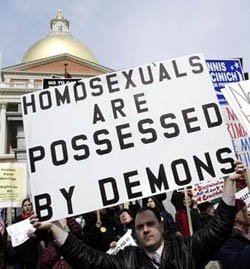  Homosexuality
has always been particularly common in single sex institutions
(such as prisons, mental asylums, sailing ships and boarding
schools) and no less so in religious ones (monasteries, nunneries,
seminaries, etc.). Medieval Church commentators freely admitted
that homosexuality was common among clergy12.
St Peter Damian was particularly worried by priests who engaged
in homosexual activity with each other, then confessed to each
other and gave each other light penance13.
He was also critical of the practice of soliciting male penitents
who revealed their homosexual inclinations during confession.
As for other crimes, clerics tended to get off lightly, if they
were charged at all. While other offenders were executed, clerics
could expect a mild punishment, even though they provided a
high proportion of offenders14. Homosexuality
has always been particularly common in single sex institutions
(such as prisons, mental asylums, sailing ships and boarding
schools) and no less so in religious ones (monasteries, nunneries,
seminaries, etc.). Medieval Church commentators freely admitted
that homosexuality was common among clergy12.
St Peter Damian was particularly worried by priests who engaged
in homosexual activity with each other, then confessed to each
other and gave each other light penance13.
He was also critical of the practice of soliciting male penitents
who revealed their homosexual inclinations during confession.
As for other crimes, clerics tended to get off lightly, if they
were charged at all. While other offenders were executed, clerics
could expect a mild punishment, even though they provided a
high proportion of offenders14.
Despite the prevalence of homosexuality in their own ranks,
Churches have, until the last few years, consistently expressed
abhorrence at homosexual practices. Now, for the first time,
some of the traditional views have been softened, and homosexuality
is accepted by the Church of England, for example, merely as
"falling short of the Christian ideal". In the Republic
of Ireland homosexual acts such as kissing could until the 1990s
incur two years in prison with or without hard labour. Buggery
was punishable by penal servitude for life.
|
This Christian work suggests that acceptance
of homosexualy has led to huge increases in mass murder
and serial murder.
|
|
|
  The
traditional Christian line, that homosexuals should be executed,
is still held be traditionalists Christians. As they correctly
point out it is the modern Christian Churches that have changed
their views - they themselves are merely holding true to the
historic teaching of all main denominations. The
traditional Christian line, that homosexuals should be executed,
is still held be traditionalists Christians. As they correctly
point out it is the modern Christian Churches that have changed
their views - they themselves are merely holding true to the
historic teaching of all main denominations.
Christian attitudes to homosexuals reverberate in other ways.
For example, the Church enjoys exemptions from laws on sexual
orientation in many countries so that it can continue to discriminate.
Every major natural disaster is still accompanied by sermons
from pulpits asserting that the disaster is God's punishment
for unchristian sexual activity. Many senior Churchmen have
declared as a fact that the AIDS epidemic is a punishment from
God for homosexual activity among men. No senior Churchmen seem
to have addressed the questions that naturally arise, such as
what God had against recipients of blood transfusions, or why
lesbians have lower rates of AIDS and all other venereal infection
than heterosexuals. The obvious corollary is that God must approve
of lesbianism.
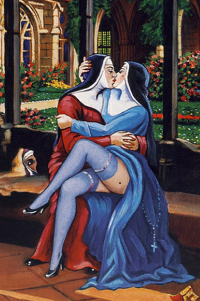  With
the possible exception of New Haven, lesbians seem never to
have been persecuted by Christians as homosexual men were. Indeed
the phenomenon seems to have been largely unnoticed. Famously,
the crime of lesbianism never made it onto Victorian British
statutes because no one was prepared to try to convince Queen
Victoria that lesbianism existed. With
the possible exception of New Haven, lesbians seem never to
have been persecuted by Christians as homosexual men were. Indeed
the phenomenon seems to have been largely unnoticed. Famously,
the crime of lesbianism never made it onto Victorian British
statutes because no one was prepared to try to convince Queen
Victoria that lesbianism existed.
A number of medieval nuns experienced and recorded hallucinations
that they regarded as divine visions and which lead them to
kiss each other on their open mouths, eventually leading to
a sort of divine ecstasy.
One cannot help but imagine that it suited all concerned not
to understand the underlying motivation for and consequences
of these phenomena, and to regard them as another form of religious
rapture, just as sadomasochistic
hallucinations and practices were seen as pure and holy.
|
After a "100 percent Christian"
Anders Behring Breivik murdered 77 people in Norway on
22 July 2011, American Christians were quick to identify
him as God's agent against homosexuality
By 2001 such views seemed eccentric, but they are in line
with historical Christian teachings, where all sorts of
disasters were blamed on sinners such as homosexuals who
had defied God's commandments.
|
|
|
|
|
|
|
|
|
|
|
|
|
|
|
|
|
|
|
|
|
|
|
|
|
|
|
|
|
|
|
|
|
|
|
|
|
|
|
|
|
Buy the Book from Amazon.com
|
|
|
|
|
|
Buy the Book from Amazon.co.uk
|
|
|
| |
| |
| More Books |
|
|
|